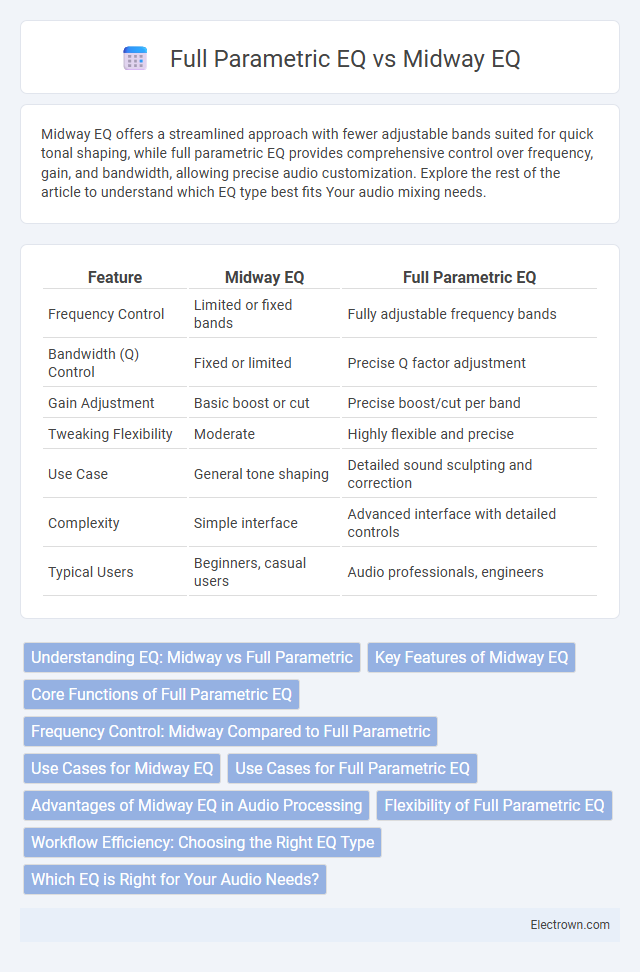Midway EQ offers a streamlined approach with fewer adjustable bands suited for quick tonal shaping, while full parametric EQ provides comprehensive control over frequency, gain, and bandwidth, allowing precise audio customization. Explore the rest of the article to understand which EQ type best fits Your audio mixing needs.
Table of Comparison
| Feature | Midway EQ | Full Parametric EQ |
|---|---|---|
| Frequency Control | Limited or fixed bands | Fully adjustable frequency bands |
| Bandwidth (Q) Control | Fixed or limited | Precise Q factor adjustment |
| Gain Adjustment | Basic boost or cut | Precise boost/cut per band |
| Tweaking Flexibility | Moderate | Highly flexible and precise |
| Use Case | General tone shaping | Detailed sound sculpting and correction |
| Complexity | Simple interface | Advanced interface with detailed controls |
| Typical Users | Beginners, casual users | Audio professionals, engineers |
Understanding EQ: Midway vs Full Parametric
Midway EQ offers limited frequency controls with fixed bandwidths, making it ideal for quick tonal adjustments and broad frequency shaping. Full parametric EQ provides comprehensive control, allowing users to adjust frequency, gain, and bandwidth (Q factor) independently, enabling precise sound sculpting and problem-solving. Sound engineers prefer full parametric EQ for detailed mixing tasks due to its flexibility and accuracy in targeting specific frequency ranges.
Key Features of Midway EQ
Midway EQ offers a balanced approach between fixed-band and full parametric equalizers by providing semi-adjustable frequency bands with variable gain and limited Q control. Its key features include simplified user interface, ease of use for quick tonal adjustments, and an efficient workflow suitable for both beginners and intermediate audio engineers. The midway EQ is ideal for applications that require more flexibility than fixed EQ but less complexity than a full parametric equalizer.
Core Functions of Full Parametric EQ
Full parametric EQ provides precise control over frequency, gain, and bandwidth, enabling you to target specific audio elements with accuracy. Unlike midway EQ, which offers limited bands and fixed frequencies, full parametric EQ allows seamless adjustments to shape your sound, reduce unwanted noise, and enhance tonal balance. This flexibility is essential for professional mixing and mastering, delivering clear and well-defined audio results.
Frequency Control: Midway Compared to Full Parametric
Midway equalizers offer limited frequency control by providing fixed or semi-adjustable bands, making it simpler but less precise than full parametric EQs. Full parametric equalizers allow you to sweep frequencies continuously and adjust bandwidth (Q factor), delivering detailed tonal shaping and precise correction. Your ability to target specific problem frequencies or enhance desired tones is significantly greater with full parametric EQs, ensuring optimal mix clarity and balance.
Use Cases for Midway EQ
Midway EQ is ideal for quick tonal adjustments and is commonly used in live sound environments where fast, effective changes are essential. It offers semi-parametric control that balances between fixed-frequency EQs and full parametric EQs, making it suitable for engineers needing moderate flexibility without complexity. This type of EQ excels in scenarios requiring both precision and efficiency, such as on-stage mixing or broadcast situations.
Use Cases for Full Parametric EQ
Full parametric EQ provides precise control over frequency, gain, and bandwidth, making it ideal for surgical audio adjustments and mixing in professional studios. It allows you to target problematic frequencies with accuracy, enhancing clarity and balance in complex sound environments. Your ability to fine-tune specific frequency ranges helps achieve polished, high-quality audio results unattainable with simpler EQ types like midway EQ.
Advantages of Midway EQ in Audio Processing
Midway EQ offers precise frequency control with fewer bands, enhancing clarity and reducing phase distortion compared to full parametric EQs. Its streamlined interface allows for faster adjustments in live audio settings, improving workflow efficiency without sacrificing tonal accuracy. Midway EQ also requires less CPU power, making it ideal for real-time processing and resource-constrained environments.
Flexibility of Full Parametric EQ
Full parametric EQ offers unparalleled flexibility by allowing precise adjustments of frequency, bandwidth (Q), and gain for each band, enabling targeted sound shaping. Unlike a midway EQ, which typically provides limited control over frequency bands and fixed bandwidths, full parametric EQs empower audio engineers to isolate and manipulate specific problem areas or enhance particular frequencies with surgical accuracy. This higher granularity facilitates more refined tonal balance and creative sound design in mixing and mastering processes.
Workflow Efficiency: Choosing the Right EQ Type
Midway EQs streamline your workflow by providing preset frequency bands and fixed Q values, making quick adjustments faster and more intuitive for broad tonal shaping. Full parametric EQs offer precise control over frequency, gain, and bandwidth, enabling detailed surgical corrections and tailored sound design but often requiring more time and expertise to dial in settings. Selecting the right EQ type depends on your project needs, balancing efficiency with the level of control necessary for optimal audio refinement.
Which EQ is Right for Your Audio Needs?
Midway EQ offers a simplified approach by targeting specific frequency bands, making it ideal for quick adjustments and beginners seeking straightforward control. Full parametric EQ provides extensive flexibility with adjustable frequency, gain, and bandwidth, catering to professionals who require precise tonal shaping and problem-solving capabilities. Your choice depends on whether you prioritize ease of use or detailed audio customization for your projects.
midway eq vs full parametric eq Infographic

 electrown.com
electrown.com